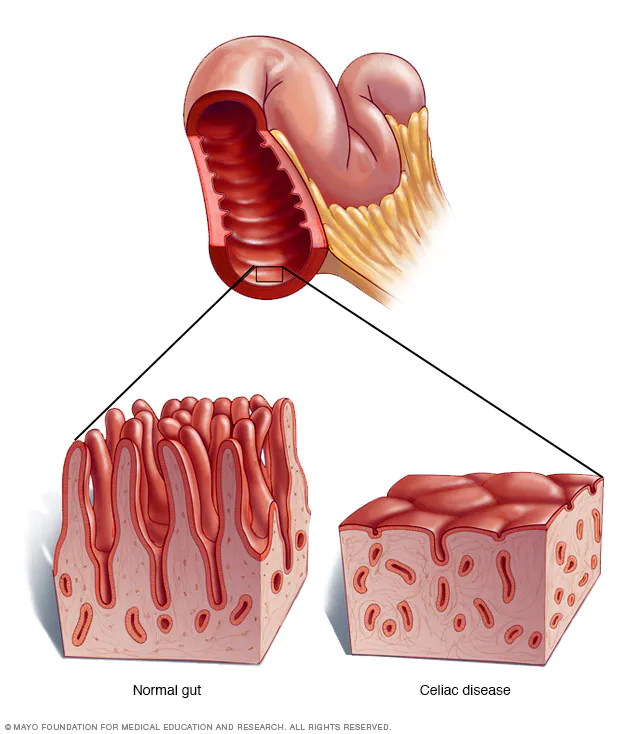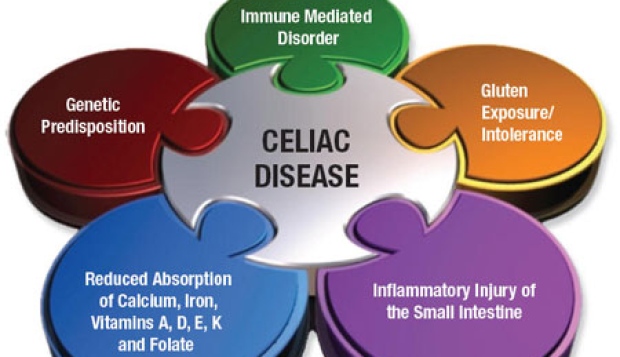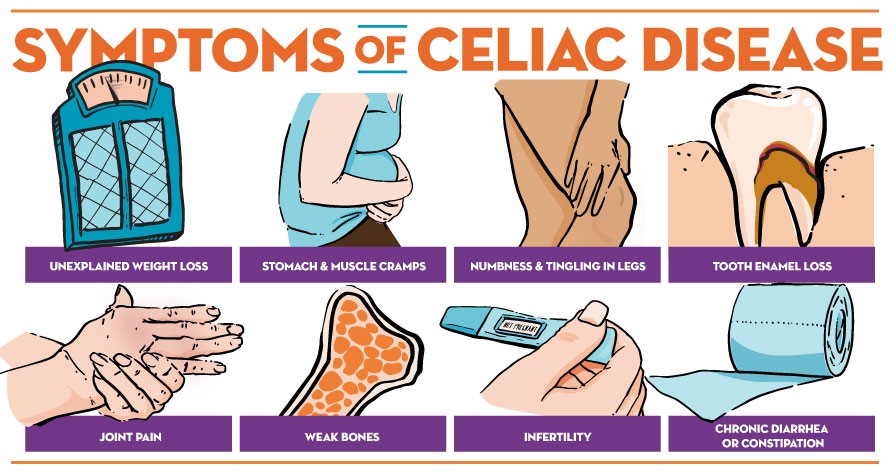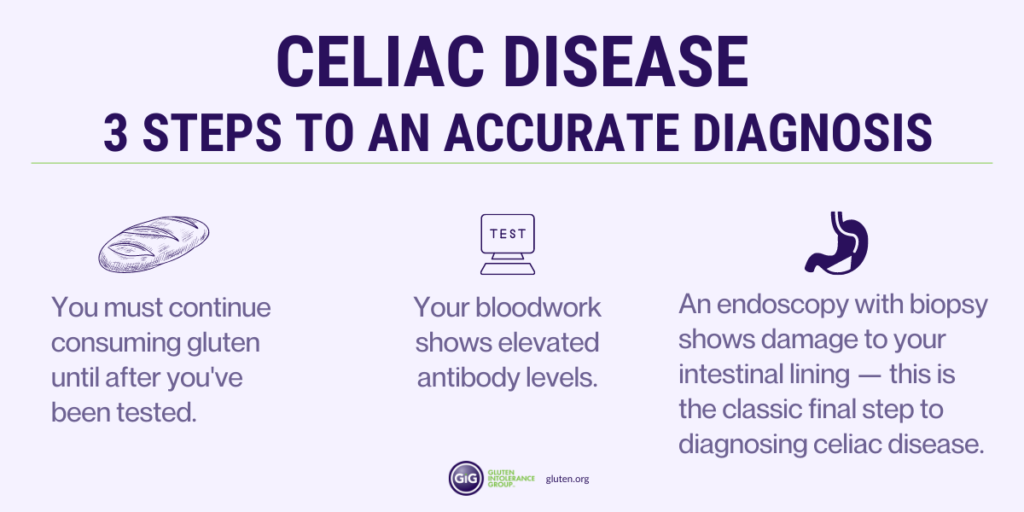Celiac Disease
- What is celiac disease?
- Who is more likely to develop celiac disease?
- What other health problems do people with celiac disease have?
- What are the symptoms of celiac disease?
- How do doctors diagnose celiac disease?
- Treatment for Celiac Disease
- Gluten-free diet


What is celiac disease?
Celiac disease is a chronic digestive and immune disorder that damages the small intestine. The disease is triggered by eating foods containing gluten. Gluten is a protein found naturally in wheat, barley, and rye, and is common in foods such as bread, pasta, cookies, and cakes. Many products contain gluten, such as prepackaged foods, lip balms and lipsticks, toothpastes, vitamin and nutrient supplements, and, rarely, medicines.
Celiac disease can be serious. The disease can cause long-lasting digestive problems and keep your body from getting all the nutrients it needs. Celiac disease can also affect the body outside the small intestine.
Celiac disease is different from gluten sensitivity or wheat intolerance. If you have gluten sensitivity, you may have symptoms like those of celiac disease, such as abdominal pain and tiredness. Unlike celiac disease, gluten sensitivity does not damage the small intestine.
Who is more likely to develop celiac disease?
Celiac disease can only occur in people who have certain genes. You are more likely to develop celiac disease if someone in your family has the disease.
Celiac disease affects children and adults in all parts of the world. In the United States, celiac disease is more common among white Americans than among other racial or ethnic groups. A celiac disease diagnosis is more common in females than in males.

- Celiac disease is also more common in people who have certain chromosomal disorders, such as Down syndrome, Turner syndrome, and Williams syndrome.
- What other health problems do people with celiac disease have?
- Experts have found that some people have both celiac disease and other disorders related to the immune system. These disorders include
- type 1 diabetes
- thyroid diseases, such as Hashimoto’s disease, Graves’ disease, Addison’s disease, and primary hyperparathyroidism
- selective immunoglobulin A (IgA) deficiency, a condition in which your body makes little or no IgA, an antibody that fights infections
- rheumatic diseases, such as Sjögren’s syndrome
- liver diseases, such as autoimmune hepatitis, primary sclerosing cholangitis, and primary biliary cholangitis

What are the symptoms of celiac disease?
Symptoms of celiac disease vary widely, and a person may have multiple symptoms that come and go. If you have celiac disease, you may have digestive problems or other symptoms. Digestive symptoms are more common in children than in adults. Digestive symptoms of celiac disease may include։
- bloating
- chronic diarrhea
- constipation
- gas
- lactose intolerance due to damage to the small intestine
- loose, greasy, bulky, and bad-smelling stools
- nausea or vomiting
- pain in the abdomen
- For children with celiac disease, being unable to absorb nutrients at a time when they are so important to normal growth and development can lead to
- damage to the permanent teeth’s enamel
- delayed puberty
- failure to thrive, meaning that an infant or a child weighs less or is gaining less weight than expected for his or her age
- mood changes or feeling annoyed or impatient
- slowed growth and short height
- weight loss
- Some people with celiac disease have symptoms that affect other parts of the body. These symptoms may include
- dermatitis herpetiformis
- fatigue, or feeling tired
- joint or bone pain
- mental health problems, such as depression or anxiety
- nervous system symptoms, such as headaches, balance problems, seizures, or peripheral neuropathy reproductive problems in women and girls—which may include infertility, delayed start of menstrual periods, missed menstrual periods, or repeated miscarriages and male infertility
- symptoms involving the mouth, such as canker sores; a dry mouth; or a red, smooth, shiny tongue
- Most people with celiac disease have one or more symptoms before they are diagnosed and begin treatment. Symptoms typically improve and may go away after a person begins eating a gluten-free diet. Symptoms may return if a person consumes small amounts of gluten.
- Depending on how old you are when a doctor diagnoses your celiac disease, some symptoms, such as short height and tooth defects, may not improve. People with celiac disease who have no symptoms can still develop complications over time if they do not get treatment.
How do doctors diagnose celiac disease?
Doctors use information from your medical and family history, a physical exam, a dental exam and medical test results to look for signs that you might have celiac disease and should be tested. Doctors typically diagnose celiac disease with blood tests and biopsies of the small intestine.


Treatment for Celiac Disease
Doctors treat celiac disease by helping people to follow a gluten-free diet. Gluten is a protein found naturally in certain grains, including wheat, barley, and rye. Gluten is also added to many other foods and products. In people who have celiac disease, consuming gluten triggers an abnormal immune system reaction that damages the small intestine.
Diet
Currently, the only effective treatment for celiac disease is a lifelong gluten-free diet. There is no medicine that will prevent the disease if gluten is present in the food. Strict Diet
Currently, the only effective treatment for celiac disease is a lifelong gluten-free diet. There is no medicine that will prevent the disease if gluten is present in the food. Strict diet helps rebuild the bowel wall, leading to elimination of almost all symptoms, and depending on how early the diet is started, the risk of osteoporosis and bowel cancer can be reduced, sometimes even eliminated.

The help of a nutritionist is necessary so that the patient knows which foods contain gluten, which are harmless, and despite the restrictions, how to keep a balanced diet. In many countries, gluten-free foods are available with a doctor’s prescription. Gluten-free foods are usually more expensive and harder to find than gluten-containing foods.

